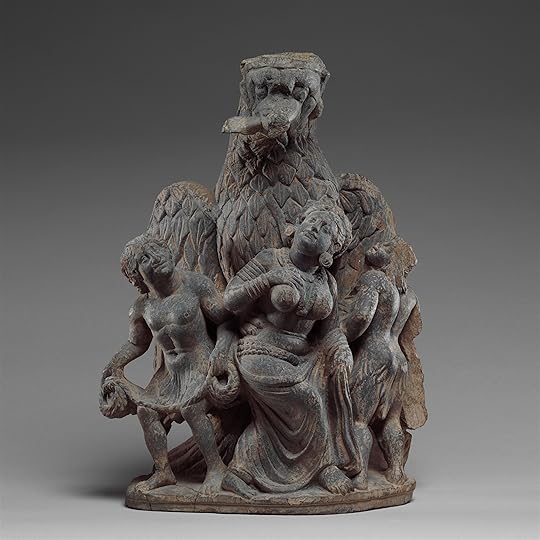ABDUCTION OF GANYMEDES BY ZEUS - EAGLE: DIFFUSION OF A MOTIF ..
Το σπάνιο θέμα σε αυτόν τον αργυρό δίσκο της ύστερης Σασσανιδικής περιόδου έχει δεχθεί διαφορετικές ερμηνείες στο πλαίσιο της Ζωροαστρικής ή της Βουδιστικής μυθολογίας, αν και μπορεί επίσης να θεωρηθεί ως αλληγορία. Πλαισιωμένος από δύο δέντρα στο κεντρικό τμήμα παρίσταται ιπτάμενος αετός, ο οποίος πιθανότατα θα πρέπει να θεωρείται ότι μεταφέρει την ψυχή ενός νεκρού στον ουρανό. Η ψυχή εμφανίζεται ως γυμνή γυναικεία μορφή, η οποία τροφοδοτεί τον αετό με τις 'καλές πράξεις του Τσερ', οι οποίες ανήκουν στις αντιλήψεις του Ζωροαστρισμού, και οι οποίες θα πρέπει να γίνονται μέρα και νύχτα. Παρακάτω, κάτω από τα φτερά του αετού, δύο αγόρια δεξιά & αριστερά φέρουν το μεν ένα ένα τόξο - συμβολίζοντας την ημέρα - το δε άλλο ένα τσεκούρι για να συμβολίσει την νύχτα. Γίνεται επιδέξια χρήση εγχαράξεων για την επισήμανση λεπτομερειών όπως το χτένισμα της γυναίκας, το δαχτυλίδι κοσμημάτων στο αυτί της και τα βραχιόλια στα χέρια και τα πόδια της, καθώς και τα πουλιά, τα αυτιά και τα φτερά. Το περίγραμμα έχει την μορφή φυτικής έλικας, διακοπτόμενες από άνθη - ρόδακες και φοινικόφυλλα, ρόδια και τσαμπιά σταφυλιών, σκυλιά και πουλιά που τρέχουν, σύμβολα των δημιουργιών της Ζωροαστρικής μορφής, Ahura Mazda (The Η δυναστεία των Σασσανιδών (226-642) κυβέρνησε την τελευταία μεγάλη περσική αυτοκρατορία πριν από την κατάκτηση των Μογγόλων.
Dish: Eagle Bearing a Woman, Iran, First half of the 7th century
The rare subject on this late Sassanian silver dish has different interpretations in the context of either Zoroastrian or Buddhist mythology, although it might also be perceived as an allegory. Framed by two trees in the central medallion is a flying eagle, who should probably be understood as carrying the soul of one recently dead to the sky. The soul is shown as a naked female figure, who feeds the eagle with the tsher good deeds, which rding to Zoroastrian perceptions uld be performed day and night. Below, beneath the eaglewerful wings, are two boys right one pulling a bow symbolising day and the boy to the left holding a hatchet to indicate night. Skilful use is made of incisions to mark details such as the womanmplex plaited hairstyle and her jewellery ring in her ear and the bracelets on her arms and legs, as well as the birde, ears and feathers. The border is in the form of a vegetable tendril, in the twists of which are rosette-flowers and palmette-leaves, pomegranates and bunches of grapes, running dogs and birds, symbols of the creations of the Zoroastrian god figure, Ahura Mazda (The Sassanid dynasty (226-642) ruled the last great Persian Empire before the Mongol conquest.
 Garuda Vanquishing the Naga Clan ca. 2nd–3rd century[10]
Garuda Vanquishing the Naga Clan ca. 2nd–3rd century[10]ΔΙΑΧΥΣΗ ΣΤΗΝ ΒΟΥΔΙΣΤΙΚΗ ΑΣΙΑ
Zar Tepe πλησίον Termez,[12] σπήλαιο 165 του Kizil,[15]
ΣΗΜΕΙΩΣΕΙΣ
[5]. Hermitage Inventory Number S-217.[10]. Metropolitan Museum of Art, Accession Number: 1980.325.[12]. Azarpay 1995, p. 105.[15]. Azarpay 1995, p. 105, fig. 8.
ΒΙΒΛΙΟΓΡΑΦΙΑ
https://www.jstor.org/stable/24048818 Azarpay, G. 1995. “A Jataka Tale on a Sasanian Silver Plate,” Bulletin of the Asia Institute (New Series) 9, pp. 99-125.https://www.academia.edu/43857008/Rap...
Sengupta, A. R. 2020. "Raptor 'Rapes' Nagin. Afterlife in Buddhist Art and Culture," <https://www.academia.edu/43857008/Rap... (9 Jyly 2021).
https://www.jstor.org/stable/29757540..., K. 2002. “Reutilization of Old Images for New Iconographic Generations: The Question of the Destiny of Greek Images in the Post-Hellenistic Period,” East and West 52 (1/4), pp. 53-69.
https://heiup.uni-heidelberg.de/journ..., M. 2014. "A Mathematic Expression of Art: SinoIranian and Uighur Textile Interactionsand the Turfan Textile Collection in Berlin," Transcultural Studies 2014.1, pp. 134-163.
http://www.sino-platonic.org/complete..., V. H. 2012. "The 'Silk Roads' in Time and Space: Migrations, Motifs, and Materials," Sino-Platonic papers 228, pp. 1-308.



